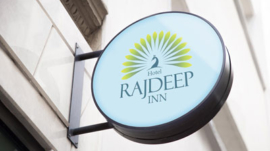The Art of Graphic Design Services Business: Unveiling Creative Graphic Design Solutions for brand
Introduction:
Do you want to create a logo that visually represents your brand in the best possible way? Look no further than the golden ratio. Also known as the divine proportion, the golden ratio is a mathematical formula used in art, architecture, and design for centuries. The human eye finds it pleasing and harmonious. Using the golden ratio in your logo design can give you a strong, recognizable brand identity that customers will easily identify with. In this blog post, we’ll explore the golden ratio in logo design and give you some tips on how to use it to your advantage.
What is the Golden Ratio?
The golden ratio is a mathematical ratio found in nature that has been used in art, design, and architecture for centuries. The ratio is approximately equal 1.618 and can be found by dividing a line into two sections, with the longer section being approximately 1.618 times the length of the smaller section. The ratio has been called the “divine proportion” because it is found in many natural forms, including seashells, trees, and even the human body.
golden ratio in nature and pyramid architecture
It’s fascinating how natural patterns can inspire design choices in the built environment. The golden ratio, a mathematical proportion that appears in nature, has a long history of influencing architecture and design. From the spiral shapes of shells to the symmetrical petals of flowers, the golden ratio can be spotted throughout the natural world. The ancient Egyptians were among the first to employ the golden ratio in pyramid architecture, in the great pyramid of giza used the mathematical formula to achieve balance and harmony in their structures. Today, this unique ratio continues to inspire designers to create beautiful and functional buildings, adding a touch of nature’s elegance to the man-made world.
Why Use the Golden Ratio in Logo Design?
Using the golden ratio in logo design can give your brand identity a visually pleasing and harmonious look. The proportion has been proven to be attractive to the human eye, making it the perfect formula for designing a logo that grabs attention. A logo that uses the golden ratio is also more likely to be memorable and recognizable, helping to build brand awareness.
How to Use the Golden Ratio in Logo Design
Now that you know what the golden ratio is and why it’s important, it’s time to start using it in your logo design. Here are a few tips to get you started:
1. Use the golden ratio to determine proportions: You can use the golden ratio to determine the proportion of different elements of your logo design, such as the size of the icon in the text.
2. Incorporate the golden spiral: The golden spiral is a visual representation of the golden ratio, and can be incorporated into your logo design to create a visually pleasing composition.
3. Use the golden rectangle: The golden rectangle has sides in the golden ratio. Using this shape in your logo design can create a sense of balance and harmony.
4. Use colors that complement the golden ratio: Certain colors, such as warm colors like red and orange, or earthy tones like brown and green, complement the golden ratio. Using these colors in your logo design can help create a visually pleasing composition.
Examples of Golden Ratio in Logo Design
There’s no doubt that logos are a crucial aspect of any brand. But did you know that the Golden Ratio, a mathematical concept derived from nature, has been applied to many iconic logos we see today? Take the Apple logo, for example. The Golden Ratio is visible in the relationship between the logo’s bite and curve, creating a sense of balance and aesthetic appeal. Another interesting example is the Twitter bird logo, whose wingspan is precisely proportionate to its body, producing a cohesive and visually pleasing design. Looking at these logos with an appreciation for the Golden Ratio can deepen our understanding and admiration for the beauty in mathematics and design.
Golden Ratio Design Company in Ahmedabad
AdVoice Inc is a leading graphic design company in Ahmedabad, known for its expertise in creating visually appealing and impactful designs. One of their signature specialties is the use of the golden ratio in their logo designs. The golden ratio, also known as the divine proportion, is a mathematical ratio that has been used in art and design for centuries to create visually appealing and harmonious compositions. AdVoice Inc understands the importance of this ratio in logo design and has perfected the art of incorporating it into their work. Their expert team of designers is skilled at utilizing the golden ratio to create logos that are not only aesthetically pleasing but also resonate with the target audience. By blending creativity with mathematics, AdVoice Inc has solidified its reputation as a top-notch design company that delivers exceptional results for their clients in Ahmedabad and beyond.
Conclusion:
Using the golden ratio in your logo design can give your brand identity a visually pleasing and harmonious look that customers will easily recognize and associate with your brand. By using the tips we’ve shared and looking at examples of logos that use the golden ratio, you’ll be well on your way to creating a visually strong brand identity that customers will remember.
The golden ratio is a mathematical ratio often found in art and design. It is denoted by the Greek letter phi (Φ) and is approximately equal to 1.618. Designers use the golden ratio to create aesthetically pleasing and harmonious proportions in their designs.
The golden ratio can be calculated using the formula: (1 + √5) / 2. This formula is used to derive the value of phi, which is the golden ratio. It can also be calculated by dividing a line into two parts so that the longer part divided by the smaller part is equal to the whole length divided by the longer part.
The golden ratio can be found in various elements of design such as architecture, photography, typography, and graphic design. It is used to create visually appealing compositions and layouts.
The golden ratio has been known to mathematicians and artists since ancient times. It was named “golden” by the ancient Greeks and is often associated with the work of mathematician Fibonacci, although its proportions were used in art and architecture long before his time.
Yes, understanding and applying the golden ratio in your designs can help create more balanced and visually pleasing compositions. It provides a guideline for harmonious proportions and can elevate the overall aesthetic of your work.
The golden ratio is closely related to the Fibonacci sequence, where each number is the sum of the two preceding ones. As the sequence progresses, the ratio of successive Fibonacci numbers approaches the golden ratio.
Yes, the golden ratio can be found in many famous works of art, including the Parthenon in Athens, the Great Pyramid of Giza, and Leonardo da Vinci’s Mona Lisa. These examples demonstrate the widespread use of the golden ratio in creating aesthetically pleasing compositions.
Yes, photographers often use the rule of thirds, which is based on the principles of the golden ratio, to compose visually appealing images. By aligning key elements with the imaginary grid created by the golden ratio, photographers can achieve balanced and compelling compositions.
The golden ratio’s proportions are believed to be inherently pleasing to the eye, and its application in design can create a sense of balance and visual harmony. By following the golden ratio, designers can achieve a sense of proportion that resonates with viewers.
The golden ratio’s prevalence in nature, art, and architecture has led to its association with great design. Its presence in diverse contexts and its connection to harmony and proportion have made it a fundamental principle for creating visually appealing and well-balanced designs.




